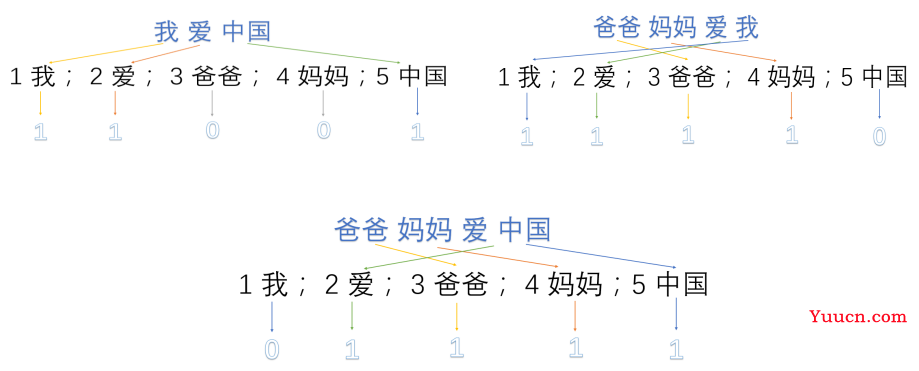one-hot编码
什么是one-hot编码
- one-hot编码,又称独热编码、一位有效编码。其方法是使用N位状态寄存器来对N个状态进行编码,每个状态都有它独立的寄存器位,并且在任意时候,其中只有一位有效。举个例子,假设我们有四个样本(行),每个样本有三个特征(列),如下图:

-
我们拿feature2来说明:这里feature2有4种取值(状态),我们就用4个状态位来表示这个特征,one-hot编码就是保证每个样本中的单个特征只有1位处于状态1,其他的都是0。

-
对于2种状态、3种状态、甚至更多状态都可以这样表示,所以我们可以得到这些样本特征的新表示,入下图:

one-ho编码将每个状态位都看成一个特征。对于前两个样本我们可以得到它的特征向量分别为
Sample_1--->[0,1,1,0,0,0,1,0,0] Sample_2--->[1,0,0,1,0,0,0,1,0]
one-hot在提取文本特征上的应用
-
one hot在特征提取上属于词袋模型(bag of words)。关于如何使用one-hot抽取文本特征向量我们通过以下例子来说明。假设我们的语料库中有三段话:
-
我爱中国
-
爸爸妈妈爱我
-
爸爸妈妈爱中国
我们首先对预料库分词,并获取其中所有的词,然后对每个此进行编号:
1我;2爱;3爸爸;4妈妈;5中国
然后使用one hot对每段话提取特征向量:
因此我们得到了最终的特征向量为
我爱中国->(1,1,0,0,1)
爸爸妈妈爱我->(1,1,1,1,0)
爸爸妈妈爱中国->(0,1,1,1,1)优缺点分析
优点:
- 一是解决了分类器不好处理离散数据的问题
- 二是在一定程度上也起到了扩充特征的作用(上面样本特征数从3扩展到了9)
缺点:
- 它是一个词袋模型,不考虑词与词之间的顺序
- 它假设词与词相互独立(在大多数情况下,词与词是相互影响的)
- 它得到的特征是离散稀疏的;
-
手动实现one-hot编码
import numpy as np
samples = ['他 毕业 于 哈佛大学', '他 就职 于 工科院计算机研究所']
# 分完词之后一般要将词典索引做好,一般叫token_index
token_index = {}
for sample in samples:
for word in sample.split():
if word not in token_index:
token_index[word] = len(token_index)+1
print(len(token_index))
print(token_index)
# 构造one—hot编码
results = np.zeros(shape=(len(samples), len(token_index)+1, max(token_index.values())+1))
for i, sample in enumerate(samples): # 索引
for j, word in list(enumerate(sample.split())): # 对list组进行链接
index = token_index.get(word) # 索引和word对应
print(i, j, index, word)
results[i, j, index] = 1
print(results)
# 改进的算法
results2 = np.zeros(shape=(len(samples),max(token_index.values())+1) )
for i, sample in enumerate(samples):
for _, word in list(enumerate(sample.split())):
index = token_index.get(word)
results2[i, index] = 1
print(results2)
运行结果


Keras中one-hot编码的实现
Keras分词器Tokenizer的办法介绍
-
Tokenizer是一个用于向量化文本,或将文本转换为序列(即单词在字典中的下标形成的列表,从1算起)的类。Tokenizer实际上只是生成了一个字典,并且统计了词频等信息,并没有把文本转成须要的向量示意。 -
from keras.preprocessing.text import Tokenizer引入模块 tokenizer = Tokenizer()
生成词典tokenizer.fit_on_texts()
string = ['他 毕业 于 哈佛大学', '他 就职 于 工科院计算机研究所']
# 构建单词索引
tokenizer = Tokenizer()
tokenizer.fit_on_texts(samples)
print(tokenizer.word_index)
将句子序列转换成token矩阵tokenizer.texts_to_matrix()
tokenizer.texts_to_matrix(samples) #如果string中的word出现在了字典中,那么在矩阵中出现的位置处标1
tokenizer.texts_to_matrix(string,mode='count') #如果string中的word出现在了字典中,那么在矩阵中出现的位置处标记这个word出现的次数
句子转换成单词索引序列tokenizer.texts_to_sequences
sequences = tokenizer.texts_to_sequences(samples)
print(sequences)
分词器被训练的文档(文本或者序列)数量tok.document_count
依照数量由大到小Order排列的token及其数量tok.word_counts
完整代码:
from keras.preprocessing.text import Tokenizer
samples = ['他 毕业 于 哈佛大学', '他 就职 于 工科院计算机研究所']
# 构建单词索引
tokenizer = Tokenizer()
tokenizer.fit_on_texts(samples)
word_index = tokenizer.word_index
print(word_index)
print(len(word_index))
sequences = tokenizer.texts_to_sequences(samples)
print(sequences)
one_hot_results = tokenizer.texts_to_matrix(samples)
print(one_hot_results)
运行结果
